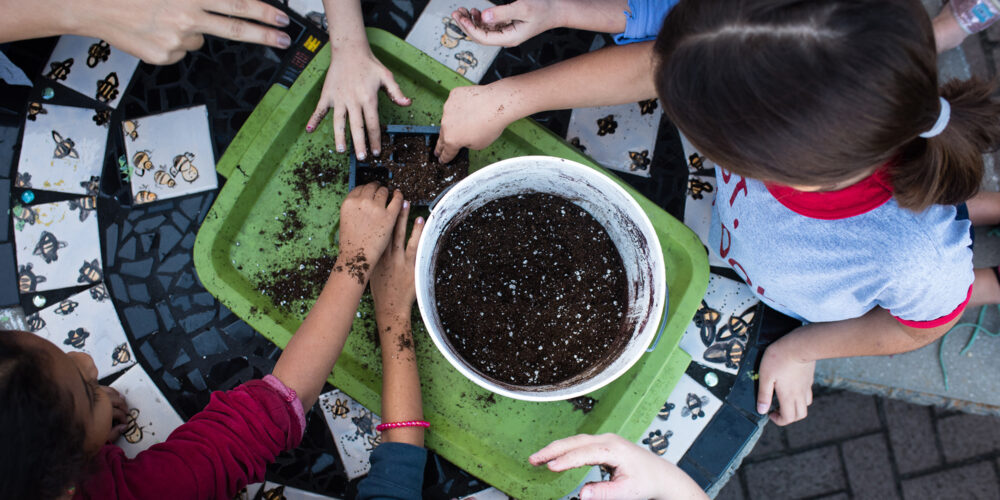
This is the first blog in a three-part series focused on small teacher actions that can significantly increase students’ ability to engage in sensemaking.
Over the next few months, we’ll dive into sensemaking and simple changes that can help teachers incorporate this practice into their lessons. Sensemaking is instruction in which students investigate — make sense of — the world around them by doing science. It’s foundational for everything else in GLEAM™ — grade-level, engaging, affirming, and meaningful — science instruction.
Picture yourself standing in the hallway between two classrooms. In each room, a teacher is kicking off a new unit with her students. The teacher in room 101 begins class with, “Hi, everyone! Today, we’re going to start Unit 4 on photosynthesis. This is a really interesting process in plants that you’re going to love.” On the other side of the hallway, the teacher in room 102 says, “Hi, young scientists. I was looking at this photograph of the trees in front of the school. I took it last winter when one tree had leaves on it and the other didn’t. Have you noticed how some trees have leaves and some don’t? Did you ever wonder why that is? Well, that’s what we’re about to figure out in Unit 4!”
How did each teacher’s opening make you feel? What did you think about? Likely, the teacher in room 102 sparked some curiosity in you. You’re ready to jump right in and make some sense of this situation that’s been right in front of you your whole life. Igniting this curiosity and setting students up to follow it is the shift toward sensemaking in a nutshell. We’re moving from a teacher saying, “Today, I’m going to talk to you about science,” to a teacher saying, “Today, you’re going to figure something out by doing science.”
Sensemaking involves:
- Starting with a phenomenon: an event or observation students can figure out and explain using grade-level science
- Inviting students to ask “how” and “why” questions they can investigate
- Creating a representation of initial ideas and revising it as new information is learned throughout the unit
- Asking questions, reading research, engaging in arguments, and planning investigations in service of figuring out the phenomenon
Sensemaking is NOT:
- The new scientific method
- A linear process
- An unplanned class where students investigate whatever they want
What are some simple steps teachers can take to get started with or upgrade sensemaking in science class?
- Start class with a question: What phenomenon are students figuring out today? A lesson objective may be, “Explain the cause of waves in the ocean.” However, a simple change to “I built a sand castle in the morning, but in the afternoon, it was gone. What happened to it?” immediately sparks curiosity and calls for an active investigation.
- End class with a question: What are we still wondering? After students have engaged with the day’s work, pose the question to find out what else they need to know to explain the science of the phenomenon. If students just figured out that there are patterns to when the waves are higher and lower on the sand, they may ask, “Sometimes waves seem bigger, and sometimes they seem smaller. Why aren’t waves all the same height?” They can explore this question the next day.
- Have students learn from discourse. Pose an open-ended question in service of figuring out the phenomenon. Instead of simply asking, “What is the definition of wave frequency?” and calling on one student to respond, try posing an open-ended question like, “Do waves consistently arrive on the shore at the same pace?” Ensure students are facing each other and encourage multiple students to share their thoughts. Use prompts such as, “Where have you observed this?” and “How can we expand on that idea?” to foster a discussion without necessarily indicating correctness. This approach engages the entire class in exploring the concept of wave frequency collaboratively rather than relying on a single student to provide a definition.
- Draw pictures and construct models to explain how something works, not what it looks like. Instead of creating a diagram and labeling a wave’s amplitude and frequency, ask students to draw a model to show what causes wave motion. Note the change here from a model of an object to a model that shows understanding of a process students for which students have made sense.
As we increase the frequency and quality of sensemaking opportunities we provide our students, we build their capacity to apply this universal skill to science they see, experience, and read about. Sensemaking builds science literacy. Stay tuned for our next blog, where we dive into the first step of sensemaking: starting with a phenomenon.
Ready to bring GLEAM™ science instruction to life?
UnboundEd supports educators in providing GLEAM — grade-level, engaging, affirming, and meaningful — science instruction. This type of instruction gives students access to rich and authentic opportunities to do and learn science.
Check out some of our previous posts for more information on GLEAM science instruction. In our last post, we highlighted the increasing complexity of the science and engineering practices throughout the K-12 trajectory.
If you are a science educator or school leader looking to increase student engagement and success with science, join us at Standards Institute™ or a Summit, and please share this blog with other science educators in your orbit!
Read the Sensemaking Series


